Canadian Military Pattern truck
 Canada (1938-1945) 400,000 built
Canada (1938-1945) 400,000 built
Chevrolet, General Motors, Chrysler, Ford Canada.
The Canadian Military Pattern vehicles, through their pugnacious presence, have become beloved of a growing band of enthusiasts around the world. But in WW2, this was a family of vehicles built by US brands in Canada; Ford, GM, Chrysler (Dodge) and Chevrolet. The difference with US models, since they shared the same mechanics, was their standardized bodywork and equipment to British requirements, hence the "pattern". They represented half of the Canadian production and served the Canadian corps well, from Tunisia to Italy, to Normandy and beyond. For the first entry in this long article, here is the Chevrolet C15 4x2 101" wheelbase or 15 cwt.
The Canadian Pattern Trucks:
pic
The Canadian Military Pattern (CMP) truck refers to a series of military vehicles used by Canada during World War II and in the post-war period. These trucks were produced in Canada and were based on British designs. The CMP trucks played a crucial role in various military operations and logistics during that time. They were manufactured in large numbers and came in various configurations, including cargo trucks, artillery tractors, ambulance vehicles, and mobile workshops, among others. They were used for transporting troops, supplies, and equipment both in Canada and overseas.
The design of the CMP trucks was robust and reliable, suited to military requirements. They featured all-wheel drive, which made them suitable for off-road operations. The trucks had a 4x4 or 6x6 configuration, depending on the model, and were powered by gasoline or diesel engines. The cargo variants could carry substantial loads and had a good off-road capability. The CMP trucks were widely deployed by the Canadian Army during World War II, supporting various campaigns, including the Italian Campaign, the Normandy landings, and the Northwest Europe campaign. They were also provided to Allied forces under the lend-lease program, supporting the war efforts of other nations.
After the war, the CMP trucks continued to serve in the Canadian military for several years, with some of them being used in the Korean War. They were gradually replaced by more modern vehicles in the following decades.
Today, the CMP trucks are highly sought after by military vehicle enthusiasts and collectors due to their historical significance. They represent an important part of Canada's military heritage and their contributions to the war effort during World War II.
It's all about Canadian Industry
The rise to power in Germany of Hitler and the Nazi party in 1933 led to discussions in the British War Office and in concertation with Canadian Army officials of a possible industrial contribution of Canada over production of military vehicles. In the Great war, Canadian land forces sent a corps in the British Army which had to be equipped woth British trucks as local indsutry was no yet able to come out with any sigbificant design. However in the 1920s notably because of the rapid development of the country, US industrialists were welcome, and soon all the great names of the US auto industry settled in Canada, notably to circumvent any tax issues. But this also enabled a strong core of local prodcution for trucks and cars, and thus for any future conflict it was assumed that Canadian forces would benefit this tile from Canadian-manufactured equipment compatible with British standards and specifications in order to mirror the tight integration of Canadian Forces withing the British Army while at the same time, not overtaxing British industry. Demographics showed Canada would indeed be able to muster twice as much troops as in WW1.
Early in 1937, the Ford Motor Company of Canada and General Motors of Canada were both invited by the Canadian Department of National Defence to provide a prototype of 15-hundredweight (cwt) ¾-ton U.S. payload rating light infantry truck. It was laregly inspired by the British Morris CS8 recently adopted by the British War Office. This was a first step, destined to provide the small Canadian army with a suitable vehicle, in peacetime. By 1938 however, heavier 4x4 and 6x4 designs were now thought after. Ford and GM Canada Ltd were asked to design a 6x4 medium artillery tractor (near copy of the British 6x4 Scammell Pioneer). In 1939, it went further as boots noises were heard in Europe, to a whole range of vehicle and mass production program, all based on a fairly strict "CMP" set of specifications (For "Canadian Military Pattern").
At first to reflect on peacetime terminology they were denominated "Department of National Defence (DND) Pattern". However shortly before September, it was no clear that production volumes were to increase several fold, while they were to serve widely in other countries's forces. The while range became "Canadian Military Pattern" (CMP). In fact, much earlier than in the US, the whole Canadian automobile industry was shifted over military production and the staff was condfident it could outpace German military vehicle's production (Combined with the British Industry that is) after September 1939. This was not the only commonwealth effort in that matter; Australia, India and South Africa all had some local manufacturing as well. All came with their own range of military vehicles, including armored cars, but the "Indian Pattern", "Australian Pattern" trucks were far less known and numerous.
Initially intended for Canadian military use only, the British Army took over the bulk of these vehicles, and they were later distributed more heavenly among Commonwealth forces. The Dunkirk evacuation of 1940 notably enabled the saving on some 340,000 Allied soldiers but the British Expeditionary Force abandoned all its national production vehicles in France. Replacing these quicklt for the follow-up operations naturally drove towards Britain all Canadian production. The CMP vehicles, based on the British specifications were soon called to the rescue in large numbers.
An unprecedented Production effort
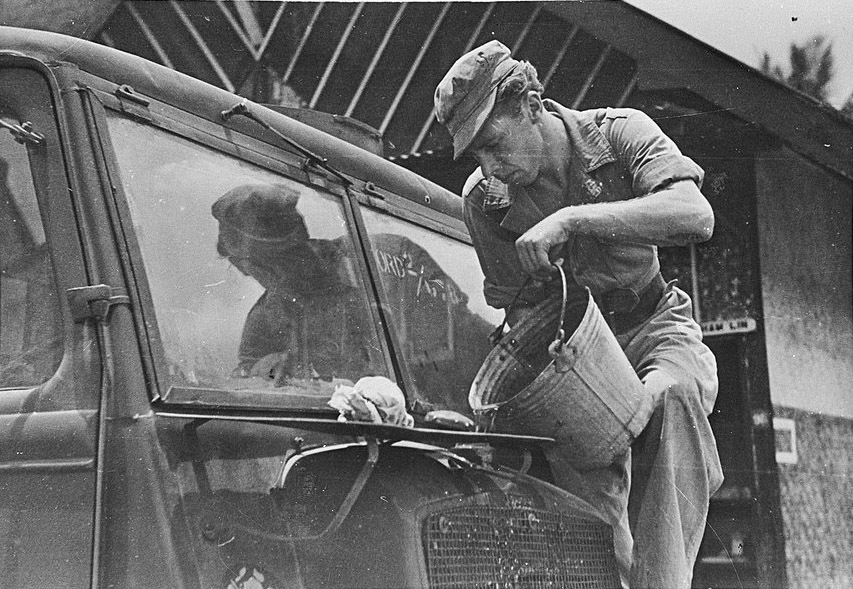 Refilling oil
Refilling oil
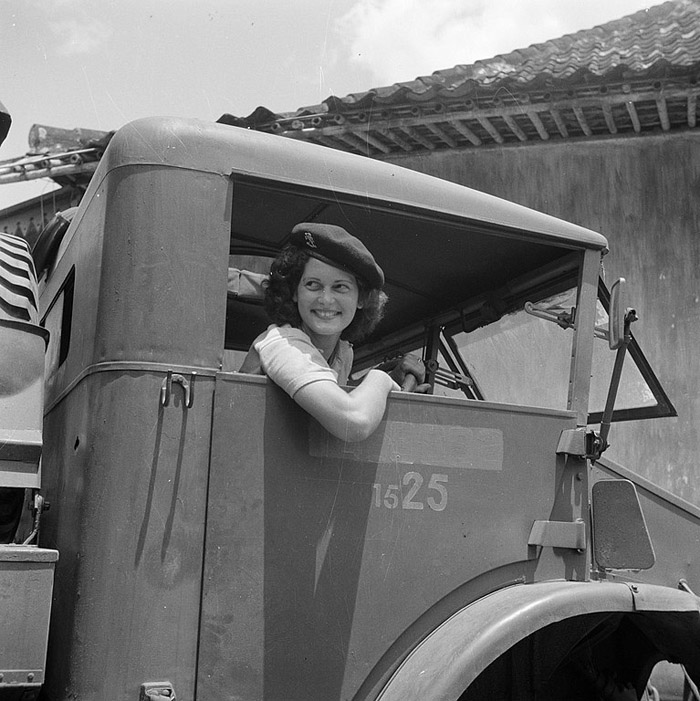 Standard Cab design
Standard Cab design
Canadian factories in grand total manufactures 850,000 vehicles from 1939 to 1945. This also included no less than 50,000 armoured vehicles but also self-propelled guns like the
Sexton, and even its own tanks the
Ram and
Grizzly, and way more than 800,000 trucks and light wheeled vehicles. At the forefront of this effort -still much lower to the US output- were Ford, General Motors, and Chrysler Canada. In fact so great was the effort that not only Canada was able to outmatched british manufacturing, but most importantly in the end, the combined German, Italian, and Japanese efforts. These were indispensible for a new kind of fast paced warfare that was reborn of the disaster of 1940 and bore fruit during
Operation Compass from December 1940 to February 1941. Using motorized columns, a much smaller British force was able to cut out, surround and defeat a much larger Italian Army. A success due to recently learned doctrine changes inspired by the German blitzkrieg and based on previous trials, notably at Salisbury plains in the interwar. This convinced the general command, especially for desert warfare, that more trucks were needed. So much were imported in fact (the bulk being CMP vehicles) that after captured by Rommel's forces they became a staple of the Afrika Korps as well...
Canada's production mosly on medium-rated vehicles rather tahn heavy ones or staff vehicles. But there was a Canadian Pattern jeep and the rest were trucks over 3 tons capacity, as required by the Canadian Army, and soon the industry focused on modified civilian commercial designs (306,000 were "Modified Conventional Pattern", or MCP), the rest being dedicated military-purpose designs or CMP.
Most CMP trucks were manufactured by the Canadian Chevrolet division of General Motors and Ford Motor Co, Canada. They were able to quickly ramp up production using reserve production capacity remaininf idle since the Great Depression but also in a typically wartime "collaboration between competitors" for interchangeable components. All this by the way later inspired US Manufacturers when starting to ramp up their own production in late 1940 and early 1941.
These were mere "assembled trucks" for the most, with parts from the US. This also simplified the supply network. However when in 1941 these parts were in turn seeked for by US manufacturers thmselves, Canada tried to source these locally. Gradually, CMP trucks were assembled from Canadian-made chassis and parts. What was interesting is that this Canadian production was increasingly delivered in knocked down form, crated, to be shipped overseas; There, in Britain, Australia, New Zealand and South Africa, some 2,600 were re-assembled locally, but also 9,500 in India and even a few in Free Italy from mid-1944 and Egypt.
Caracteristically, all CMP trucks had right hand drive (even though vehicles were left-hand drive in Canada), and peculiarities proper to the British Army needs. These CMP were for the most 4x4 vehicles that proved adaptable and versatile. They soon formed the basis for many different truck types and a few derived into armoured vehicles like the Fox, CT-15 and Otter. No less than 19 types of CMP vehicles on 12 different chassis were made, plus 3 wireless trucks, 4 ambulances, 13 field workshops. In Australian service they were nicknamed the "Chev Blitz" or "Ford Blitz".
Over the 410,000 CMP trucks "made in Canada" GM trucks alone represented 201,000, Ford making the rest, with 4x4, 3-ton trucks (Chevrolet C60S and C60L, Ford F60S and F60L) being the majority (209,000). Chrysler delivered 180,000 Dodge trucks, and again 3/4 were 3-ton trucks. But they differed from the CMP pattern, as having the standard Dodge control cabins, 2-in (50 mm) longer wheelbases and two-wheel drive. 9,500 more extra 4x4 CMP chassis were also reverved for conversion into armoured cars.
Canada's contributon to WW2 once again, alshtough not flamboyant, was remarkably impactful on the conduct of the war. Its truck production alone outdone the one of Germany by a long shot, and just like the ASW effort of the
RCAN to wing the battle of the Atlantic, production of soft-skinned trucks was an immense contribution to the Allied victory. Surplus CMP trucks were widely distributed after the war to the Netherlands, Belgium, Denmark, Norway, Portugal, Spain, South Africa, Argentina, Jordan, South Vietnam, and Malaya among others. They proved resilient and rugged, easy to maintain and repair, despite the left-hand drive. They were also recycled into many civilian roles, used by forest management offices and lumbermills, use for amm sorts of transport, but also fire-fighting vehicles and even snow-plowing ones. In Malaysia alone after the Emergency, they became log transporters or accessing difficult construction sites with upgraded brake systems and new engines, still being around in the late 1980s.
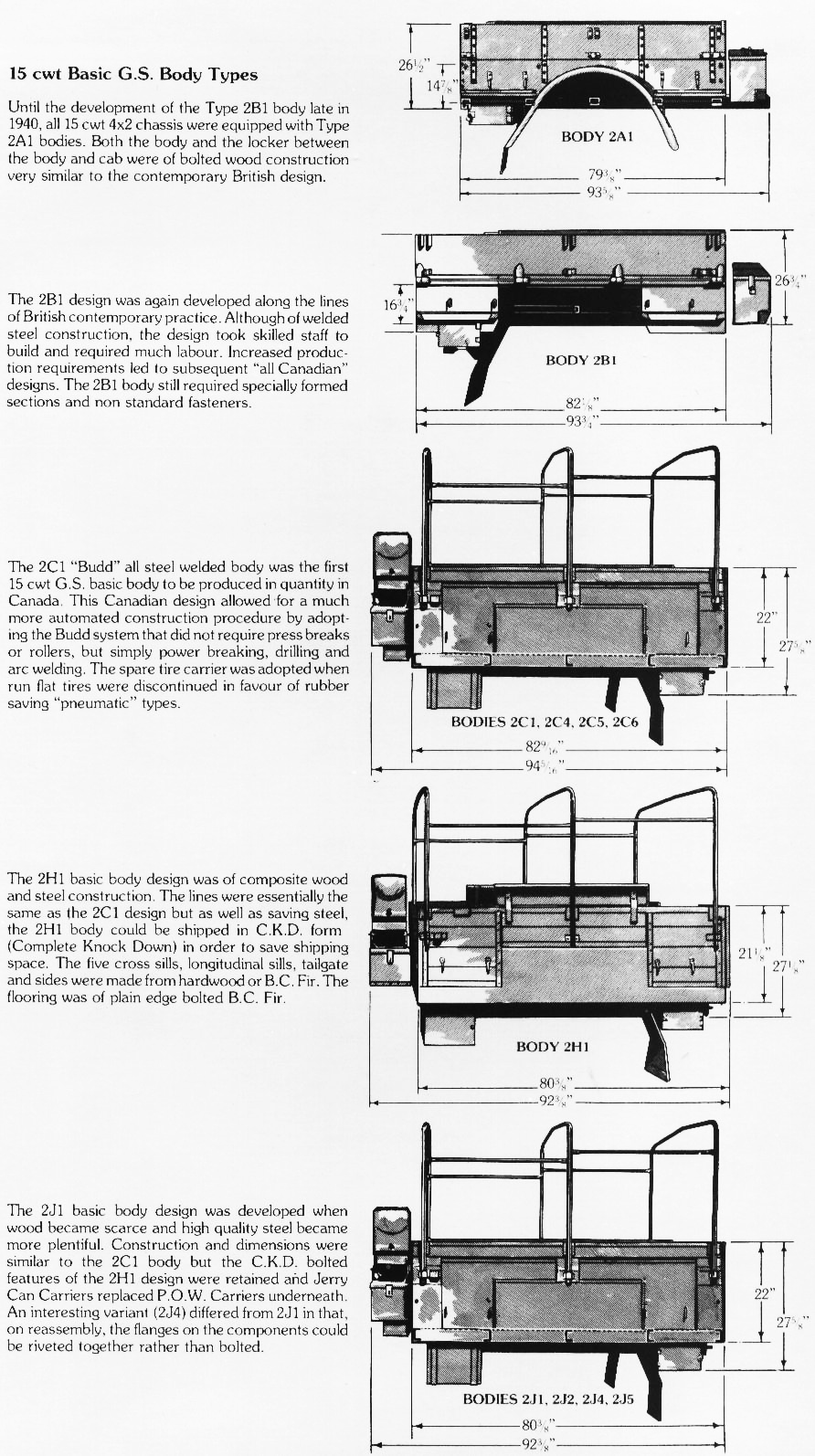 15 CWT Body
15 CWT Body
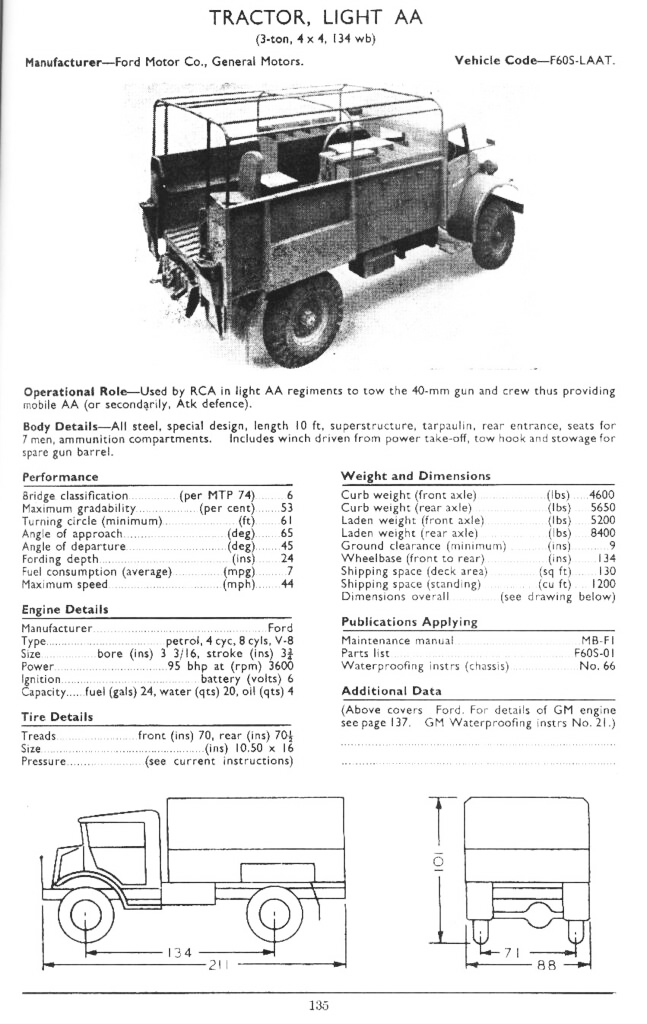 CMP LAAT data book
CMP LAAT data book
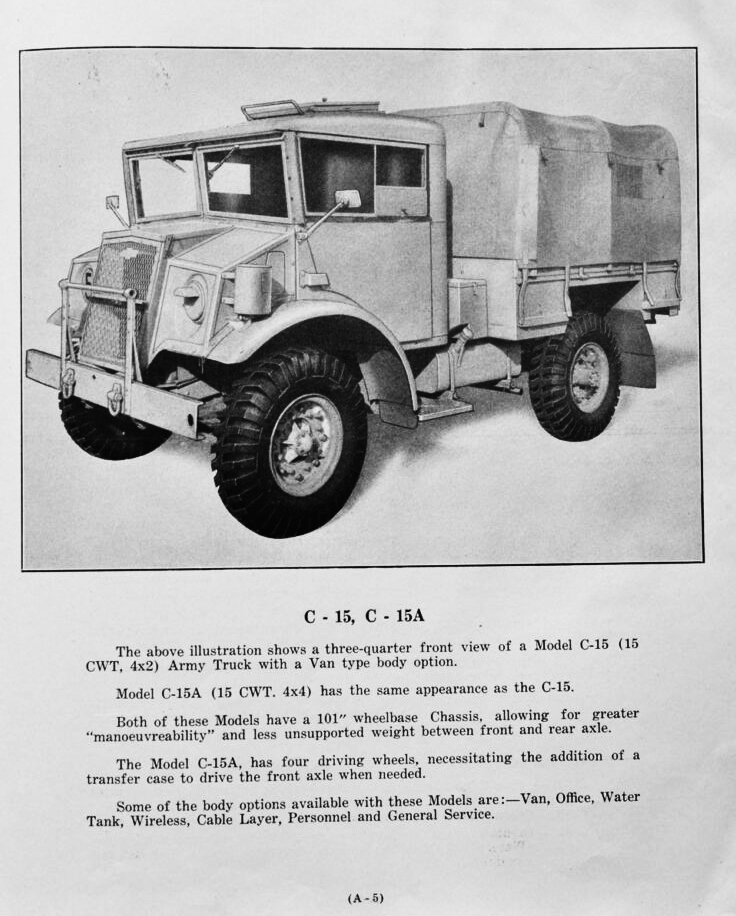 CMP Chevrolet manual C15
CMP Chevrolet manual C15
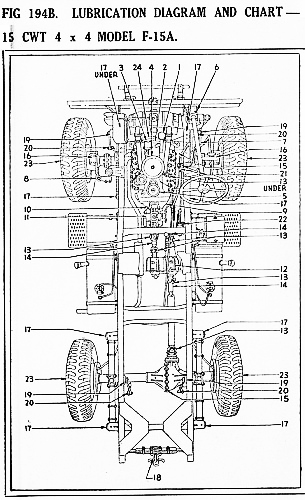 F15A chassis
F15A chassis
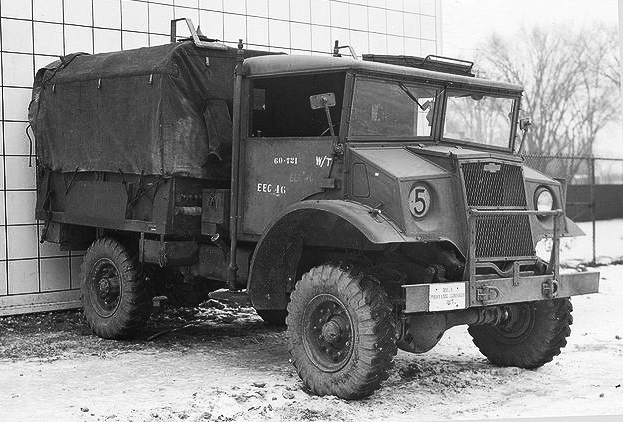 CMP Truck 15 cwt Fitted for Wireless front right
CMP Truck 15 cwt Fitted for Wireless front right
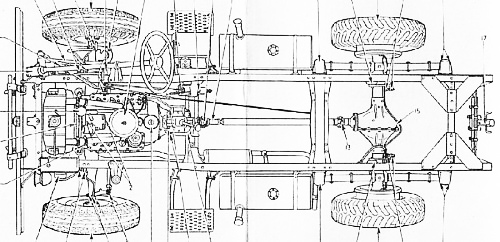 f15 chassis
f15 chassis
Commonwealth Production
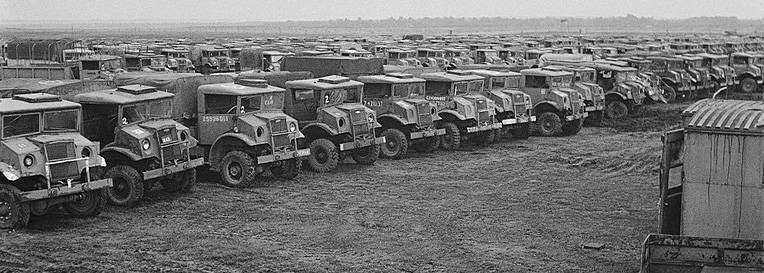 Autodump Deel CMP trucks
Autodump Deel CMP trucks
Outside Canada, many countries were put to contribution, assembling crated knock-down kits shipped from canada.
Part-assembled "knocked down" form, shipped from Newfoundland to be assembled in British factories. Air-portable versions were also developed: They had the top half of the cab superstructure and exterior components stowed to allow them to fit in the hold of large transport aircraft, to be easily re-fitted after reception. In fact this also gave the occasion to these countries to try producing light armoured vehicles with special chassis, featuring rear mounted engines, central steering. Chassis and production were licensed to the following:
Indian CMPs
Bare chassis were also shipped to fit on site special bodies, most of these being in this state when shipped to India. Bodies were locally produced in India in wood, creating a diverse range of "Indian Pattern" vehicles.
In addition, Indian Railways produced the Armoured Carrier Wheeled Indian Pattern
ACV-IP (101-inch wheelbase) in part using the CMP chassis
Australian CMPs
In addition to the vehicles assembled, Australia also tried its luck to several armoured cars:
Ruskin Motor Bodies Pty Ltd and Ford Motor Company of Australia Rover Light Armoured Car (4x4, 134.25-inch and 158.25-inch wheelbases) – built on Ford 3-ton CMP chassisw
General Motors Holden Ltd Rhino Heavy Armoured Car (4x4, 101-inch wheelbase) — prototype only
General Motors Holden Ltd 6x6 Heavy Armoured Car (6x6, 158-inch wheelbase)
South African CMPs
In addition to the assembled trucks in local facilities, South Africa created a South African Reconnaissance Car, Marmon-Herrington.
NewZealand's CMPs
New Zealand from CMP chassis trucks created the Beaverette NZ, a local variant of the British Standard Beaverette armoured car, and only national armoured vehicle of WW2. They also created the C8AX "Puddlejumper" which was a 4x4, 101-inch wheelbase, 8 cwt variant based on the C8A chassis.
List of CMP Vehicles
Ford-built CMP trucks
They used a 95 bhp (71 kW), 239 cu in (3.9 L) Ford V8 Flathead engine. They had grilles formed of a square mesh.
- Ford F8 4x2 101 in (2.6 m) 8 cwt
- Ford F15 4x2 101 inch 15 cwt
- Ford F15A 4x4 101 inch 15 cwt
- Ford F30 4x4 drive 134.25 in (3.41 m) 30 cwt
- Ford F60S 4x4 115 in (2.92 m) 3 ton "short" wheelbase
- Ford F60L 4x4 158.25 in (4.02 m) 3 ton "long" wheelbase
- Ford F60T 4x4 115 inch 3 ton tractor unit
- Ford F60H 6x4, rear axle undriven 160.25 in (4.07 m) +52 inch 3 ton
- Ford FGT 4x4, 101.25 inch Field artillery tractor
Chevrolet-built CMP trucks
The Chevrolet-built CMP trucks used a 85 bhp (63 kW), 216 cu in (3.5 L), straight-6 overhead-valve engine. The C60X 3-ton truck had an US-supplied 270 cu in (4.4 L) GMC straight-6. They also could be recognised by the radiator grille mesh being of a diamond pattern.
- Chevrolet C8 (4x2, 101-inch wheelbase, 8 cwt)
- Chevrolet C8A Heavy Utility Truck (4x4, 101-inch wheelbase, 8 cwt)*
- Chevrolet C15 (4x2, 101-inch wheelbase, 15 cwt)
- Chevrolet C15A (4x4, 101-inch wheelbase, 15 cwt)
- Chevrolet C15TA Armoured Truck (4x4, 101-inch wheelbase, 15 cwt)
- Chevrolet C30 (4x4, 134-inch wheelbase, 30 cwt)
- Chevrolet C60S (4x4, 134-inch wheelbase, 3 ton)
- Chevrolet C60L (4x4, 158-inch wheelbase, 3 ton)
- Chevrolet C60X – C60 chassis with 6x6 drive, 160 inch +52 inch wheelbase, 3 ton, 270 cu in GMC straight-6 engine)
- Chevrolet CGT Field Artillery tractor (4x4, 101-inch wheelbase)
*Declined into the Wireless (HUW), Ambulance (HUA), Personnel (HUP), Machinery ZL (mobile radio repair shop) and Computer (accounting, payroll)
Chrysler-built CMP Trucks
Dodge production started later. Early prototypes used the No. 13 cab, but production vehicles retained a commercial cab and longer conventional control similar to MCP vehicles. This enabled more rapid production, while retaining similar specifications for chassis, drive, and mounting of vehicle rear bodies.
- Dodge D8A 4x4 8 cwt
- Dodge D15 4x2 128 in 15 cwt
- Dodge D60S 4x2 136 inch 60-cwt short wheelbase
- Dodge D60S/DD 4x2 136 inch 60 cwt short wheelbase, dual rear tyres
- Dodge D60L 4x2 160 inch 60 cwt long wheelbase
- Dodge D60L/D 4x2 160 inch 60 cwt
- Dodge D60L/DD 4x2 160 inch 60 cwt mong wheelbase dual rear tyres
Shared Parts
 A CMP used by the LRDG in 1941-43. Close to it was the MCP Chevrolet WD 30 CWT 1-1/2 tons truck.
A CMP used by the LRDG in 1941-43. Close to it was the MCP Chevrolet WD 30 CWT 1-1/2 tons truck.
As said above, in a state-sponsored agreement only possible in wartime, Ford and Chevrolet trucks shared many parts: The same Sandard cab design was the most obvious. It evolved over the years of production. These were bamed No. 11, 12 and 13 cab designs. The first two were similar apart their two-part radiator grille (No. 12 cab, opened with a bonnet or "Alligator cab") whereas the No. 13 cab was purely Canadian design made (late 1941-1945) with the two flat panes of the windscreen angled slightly downward to minimize sun glare and reflections spotted by aviation.
These were all short "cab forward" style, making these CMP trucks pug-nosed and compact. This was to meet British specifications for ship transport. Internally these short engine hoods were still capable of housing the large North American engines and space was tight. In fact cooling became problematic in the desert, to the point of discarding all the panelling. These cabs were adapted to a whole range of chassis and drive trains.
Subcontractors
The bodies were subcontracted out to smaller companies in Ontario and Manitoba under supervision of the "Steel Body Manufacturers Association" as part of Department of Munitions and Supply. Truck body designs comprised the following types:
-General service (GS)
-Troop carrier
-Tanker (fuel/water vehicle)
-Vehicle recovery (tow truck)
-Field ambulance and Dental clinic
-Mobile laundry
-Wireless house radio HQ vehicle
-Mobile Workshop (machine shop and welding station)
-Folding-boat transport
-Artillery tractor
-Anti-tank gun portee (like the Chevrolet
WD30 2-Pdr portee vehicle)
To keep things in order, the documentation listed the drive specification in the naming, with NxM (total of N wheels, M wheels driven). Military specifications specified no more than two wheels per axle to simplify maintenance and supply. But with went with reduced capacity, 8 cwt (400 kg), 15 cwt (760 kg), 30 cwt (1,525 kg) and 60 cwt (3,050 kg). In US service this equated the 1/2, 3/4 ton, 1.5, and 3 short tons. The 60-cwt CMP trucks were so usually in the field called "3-ton lorries" by association with the allies.
Chevy C15/Ford F15 CWT
The Canadian Military Pattern (CMPs) Ford entry denominated under the British imperial hundredweight system ("centum weight", abbreviated CWT) had a weight equivalent to 50.8 kg. Thus the lightest Ford CMP light truck was standardized to a 760 kg payload (15 CWT), by contrast to medium trucks rated to 30 CWT (1,525 kg) and the heavies at 60 CWT, or 3,050 kg. Thus the lower tier of Ford Canada was defined around this rather small payload, but still, the truck was large enough to accomodate at least height men, two in the cabin and three either side of the flatbed aft seated as customary on either side, backs to the walls. The space in between was occupied by haversacks and equipments.
Mobility
 British CMP C30 in mobility tests, early 1941, note the early cabin type with the sloped up windshield.
British CMP C30 in mobility tests, early 1941, note the early cabin type with the sloped up windshield.
The Ford 15 CWT was powered by an US-supplied Ford 239 B9-99A Flathead engine with a capacity of 3,916 cm³ delivering 95 hp at 3,300 rpm whereas the Chevrolet equivalent was given the 3,540 cm³, 6-cylinder, in-line OHV 6 (OverHead Valve) engine delivering 85 hp at 3,400 rpm. Thus, the "Chevy" C15 was less powerful and this had consequences for performances as a whole. Both however had had a 93 liters fuel capacity for a 460 km range. Their top speed on-road varied from 64 km/h to up to 80 km/h, depending on the specific vehicle. They shared the same 4×2 configuration, keeping the name F15 or C15, but soon an all-wheel drive configuration was introduced and the name was changed to Ford F15A and Chevrolet C15A respectively. Both however shared the same wheelbase of 2.56 meters as standard (xxx inches). There was from 1941 a more powerful Ford F60 powered by a V6, but it was delivered exclusively as 4×4 for the start. The Chevrolet C15 benefited from no upgrade.
The Ford and Chevrolet C/F15 shared the exact same right-side drive cab design. It had two partially cut doors over the mudgards, same opening handle with key lock, step, and two-part side windows, same forward, all flat. The back of the cab was rounded in section. On top was a shaped stamped metal sheet roof for air flow, thinner forward than at its rear. It was still however a complex shape that could be simplified. Indeed, the cab style evolved over production years. The cab was originally designed by Ford's Sidd Swallow. Soon the cab types were denominated Number 11, No. 12, and 13. The Chevy C15 had the mesh of the radiator grille diamond-shaped (square mesh for the C15).
The original ford "nose" No.11 had radiator grille and was roughly similar to the No. 12. However soon in 1941 production was standardized on the Canadian designed "No. 13 cabin" which flat panels of the windshield were slightly tilted downward to reduce glare. They could be also opened (lifted up) to be opened and allow some ventilation. Indeed comfort was lacking. As military trucks, they lacked amenities. Plus, due to heir generous rear wheel fairings, cargo bays were quite small and cramped. They were modelled much on the larger Morris CS8, (same payload). Bith both the C15, F15, Morris C8, as well as the Ford F30, Chevrolet C30, Ford F60, and Chevrolet C60 formed the backbone of the commonwealth armies until 1945.
Variants of the C15/F15
Basically the C15 and F15 existed in basic flatbed version, with optional arches and tarpaulin, cabin version (workshop, radio, ambulance...), fuel/oil tank version although it seems larger chassis were preferred. There was a,so a properly armoured version (see below), the CT15A. Last but not least there were axis captured variants used as AA portée. In German service with a 20 mm FLAK 38 or Breda of the same caliber. The 4x4 C15A and F15A were preferred for this.
The C15 CMP Troop Carrier (HUW)

From Pinterest. The dedicated troop carrier was a 4x4 F15 or C15 chassis fitted with a new flatbed and new rigid cabin that covered all the lenght. It had a single spare wheel at the left, and rear door, plus windows all around. Eight seats on two bunks behind, driver and co-driver at the front. As usual the co-driver could use the small hatch to stand and shout orders, wave signal flags or use a Bren Gun for defence. This version was mostly used in Northern Europe, better protecting the troops than usual canvas-topped vehicles which tended to leak. Another popular variant was the Chevrolet C8 4x4 CMP HUW.
The armoured CMPs
CMP chassis were used for at least five types of Armoured Car, detailed below.
Chevrolet CT15A
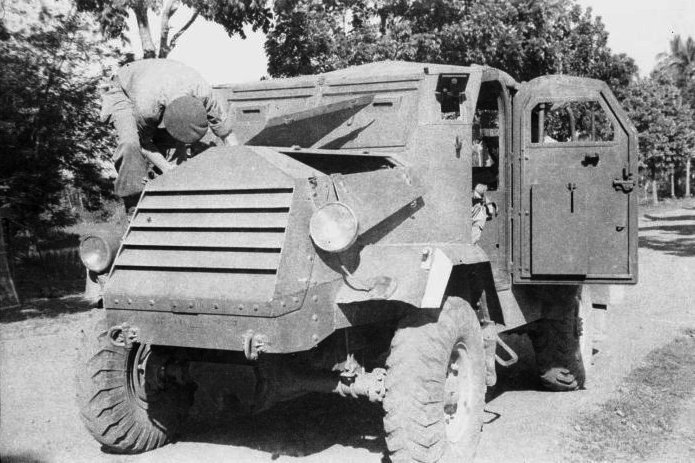
Probably the most direct adaptation of the light CMP chassis, it was developed by General Motors Canada as an alternative to the American M3 Scout Car. It was based on the Canadian Chevrolet C15A, the 4x4 light Canadian Military Pattern truck variant. Between 1943 and 1945 3,961 units of these were built in Oshawa, Ontario, making it the most common Canadian Armoured Car. Armoured hulls were supplied by Hamilton Bridge.
Chevy/Ford Fox Armoured Car
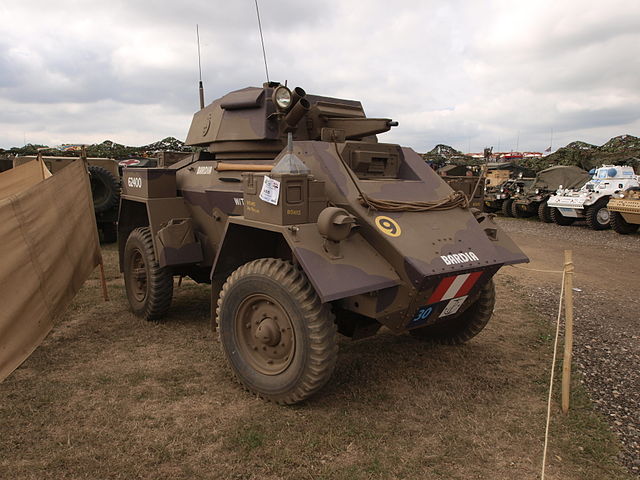
The Fox Armoured Car was a Humber Armoured Car adapted to a CMP chassis. It was built by General Motors Canada and mostly used by Canada and after the war by Portugal and the Netherlands. The Ford Lynx Scout Car oficially "Car, Scout, Ford Mark I" married the Daimler Dingo to a 15 Cwt CMP chassis and was significantly different (They are to be seen on tank-afv.com).
Otter Armoured Car
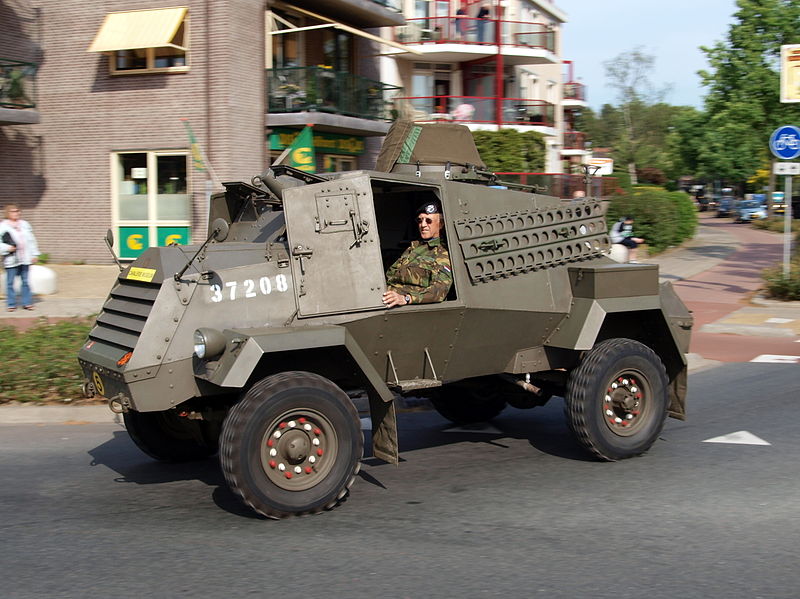
General Motors Canada built 1,761
Otter Light Reconnaissance Cars, an adaptation of the Humber Light Reconnaissance Car Mark III for a C15 chassis.
specifications C15/F15 |
| Dimensions | Wheelbase 101 inches (2.56 meters) |
| Payload | 760 kg or 3/4 ton payload (15 CWT) |
| Crew | 8: 2 (driver, co-driver, 6 troops) |
| Propulsion (Ford) | Ford 239 B9-99A Flathead 3,916 cm³, 95 hp @3,300 rpm |
| Propulsion (Chevy) | 6-cyl. OHV-6 85 hp @3,400 rpm |
| Transmission | |
| Top speed | 64 to 80 km/h off-road/road |
| Fuel consumption | Unknown |
| Suspension | Leaf spring, 2x4 or 4x4 |
| Maximum range | 93 liters tank, 460 km range |
| Armament | None, rooftop hatch |
| Production | See notes |
The CMP field artillery tractor (FAT), CGT/FGT

This was the main Australian production variant of the F30 by Ford Australia. However the FAT was universally adopted by the Commonwealth at large in alternative to the British Army using the Morris famous "quad".
The CMP FAT (Field Artillery Tractor) was one main variant of the Canadian Military Pattern made either Ford and Chevrolet with the same body. This artillery tractor was used by British and Commonwealth forces, and depending on the manufacturer they were called CGT (Chevrolet Gun Tractor) and FGT (Ford Gun Tractor). They shared however the early 'Quad' bodywork which was inspired by the famous Morris C8 "quad". It happened that the body was liked enough to constitute a standard for Canadian production. The name comprised the "CMP" and the manufacturer letter, followed by the utility letters, GC.
The payload varied, but it was usually the 25-pounder gun-howitzer. Some vehicles also equipped frontline units as part of anti-tank squads towing the 17-pounder anti-tank gun. The CGT/FGT had both the same power winch located above the rear axle for manoeuvring the gun, which also worked to recover the vehicle. The front cabin comprised the driver and co-driver with four seats behind in a single row facing forward, and the ammunitions partly stored in rear bins, accessed through several doors. The vehicle often towed an extra ammo trailer for the 25-pdr. It also had a spare wheel rlocated on the back of the sloped body, above the spare ammunition.
The Morris C8 had in its "quad", FAT variant a very similar bodywork to the early CMP FAT but differing by its five-sided windscreen glass with the upper corner cut away while the CMP had a four-sided screen. All of these bodyworks had a rear canvas roof which can be open for ventilation. There two more small hatches down the slope. None of these vehicles were armoured, nor armed. The gun crews only shared personal weapons, a few sten guns and pistols, rifles in some cases. The co-driver left roof hatch (often in that case the gunnery officer) could enable him standing, and in some case, manning a Bren Gun for AA defence if available. It should be noted that Guy also developed for the British Ministry an artillery tractor for the 18 and 25 pdr in 1938 nicknamed "Ant". Since production by Guy was limited, it was given also to Ford (named F-GT) and GM as C-GT, but on an British Ford chassis, not the Canadian CMP. This British FGT measured 4.49 m x 2.21 m x 2.26 m for 3t. powered by a Morris EH 4-cy. 3.5 litre petrol 70 hp engine (20.6 hp/t), capable of 80 km/h and 257 km range. This was pretty similar for the CMP vehicles but the body was different.
see also.
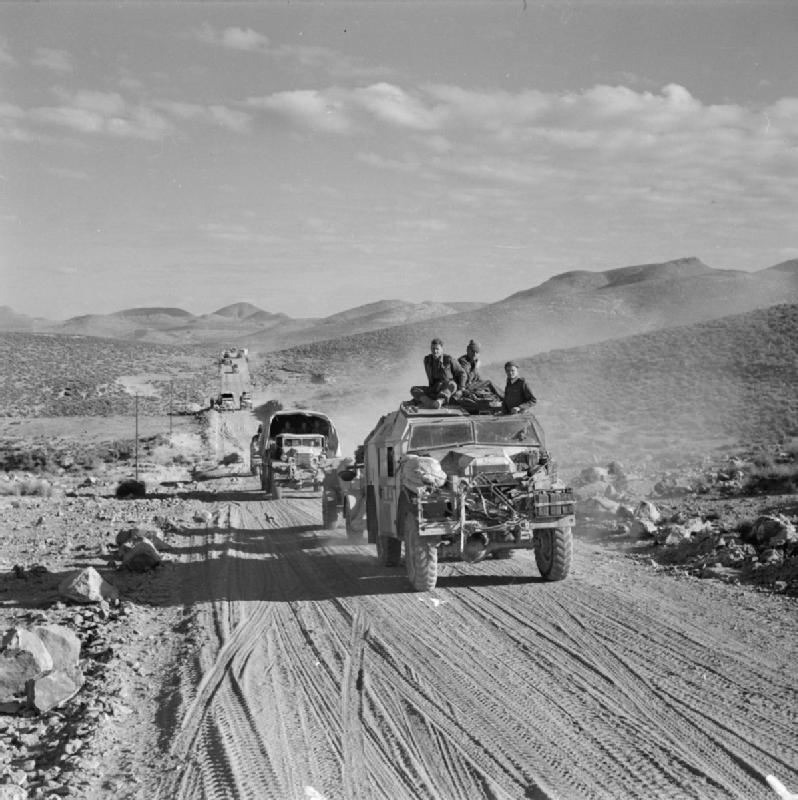 A Chevrolet FAT (Field Artillery Tractor) towing a 25-pdr leads a column of other vehicles on a road during the 8th Army's approach to Azizia, south of Tripoli, 27 January 1943.
A Chevrolet FAT (Field Artillery Tractor) towing a 25-pdr leads a column of other vehicles on a road during the 8th Army's approach to Azizia, south of Tripoli, 27 January 1943.
Main Variants
-Chevrolet 8440/CGT Tractor, 4x4, Field Artillery
-Ford C291Q FGT Tractor, 4x4, Field Artillery

Bodies (for the CGT/FGT)
- 7A1 beetle-back body with two doors and solid roof
- 7A2 beetle back body with two doors and open (canvas covered) centre roof section
- 7B1 beetle-back body with four doors and open (canvas covered) centre roof section
- 7B2 beetle-back body with four doors and open (canvas covered) centre roof section. Tyre carrier on rear sloped roof.
- 7B3 Open body canvas roof with four doors Tyre carrier on rear upper cargo body.
- CGT with "Australian body"
- Indian FAT: Shipped in bare chassis locally made wooden bodies with some armoured.

Ford F30/Chevy C30
 Ford F30 used by the RAAF.
Ford F30 used by the RAAF.
The Ford F30 name was related to its capacity in Imperial hundreweight (30 cwt - so a payload capacity of around 3 tons), second entry in the CMP range. It featured a robust design suitable for off-road operations and was commonly used as a transport vehicle, also equipped with a powerful engine to handle the demanding conditions of military operations. Chevrolet produced an equivalent, the C30. They were the medium Type of CMP trucks and apparently only existed as 4x4 vehicles, with a single rear axle (no twin wheels).
The Ford F30 as a four wheel drive truck was close to the Chevrolet 30 Cwt (notably sharing the same cabin, also found on the F15/C15, and the same nose, general design with the caracteristic sloped downwards windshield, and short "stout nose" recalling their near-COE (Cab Over Engine) configuration. The major advantage of the F30, its four wheel drive capability and commonality of mechanical parts made it valuable in several theaters, starting with North Africa. One of its earlier user was indeed the LRDG. Sharing many caracteristics with the Ford Pilot Cars already used, it was fount quite valuable. However designed in a cold and rainy country, this CMP was not at eas in the bunrning sand sof Africa. It was not "tropicalized", having not sand filter or reworked cooling, so the crews took matter in their own hands and removed the hood panels altogether, leaving the engine "naked" in open air only proteted by the radiator grille.

Unfortunately, the F30 was also found heavier than the Chevrolets and while patrolling, they were found unwieldy gas-guzzlers. Indeed their 4-speed Flathead V8 engines made 6 miles per gallon only. After a short career with the LRDG lasting a few patrols, it was replaced by the
Chevrolet 1533X2 30 CWT. In operations indeed, they needed to carry twice as many fuel as the Chevy 30 cwt, or required to prepare emergency fuel dumps in the desert in advance, which still could be captured by axis patrols as well. The additional fuel carried inside also reduced the useful payload, notably water, food and ammunition for the patrol. The Ford F30 as a Canadian military Pattern this was readily available, but wisely kept for regular transport on regular roads. It was still rugged and could cope with hard terrain of needed, delivering the goods to remote bases.

The F30 shared more mechanical parts with Ford CMPs and many were also interchangeable with Chevrolet CMPs. Only the LRDG vehicles had their hood reippied off fpr extra cooling, but it also had a purpose built bed with several spots to bolt on the go pintle mounts for a variety of weapons, the usual panoply of the LRDG, notably the dependable Bren, Lewis MG, water cooled Vickers in some cases, and 0.3 Browning LMG. Despite the arrival of the Chevrolet 1533x2 30 CWT they stayed as emergency replacements when one of the latter was missing, or for supplying the columns and create depots. They however were never completely retired due to the shortages of the newer trucks and remained popular with the LRDG as long as fuel consumption was not an issue.
CMP C30 Wrecker (Recovery Truck)

Outside the fuel tank variant, this CMP type used for recovery (twin-boom crane, two-pole hoisting mast, engine-driven winche, steel cable, tooling) was based on the 30cwt chassis. The same apparatus was also seen on the F60/C60 in LWB and SWB variants, which had a large engine, more torque and space.
CMP F30 Portee
Alongside other conversions using the same 2-pdr gun, the Australians deployed an improvized "tank hunter" with a 2-pdr gun installed at the back. For AA defence another variant received a mount with twin 20mm Polsten gun on the flatbed, usable for AA defense but also perhaps for infantry support if needed. These versions are going to be seen also in relation to the LRGD. The Long Range Desert Group indeed eventually selltled on the Chevrolet 1533X2 30cwt and the Jeep, but also largely depended on the CMP as seen above, and if the F15a or C15a were good off-road trucks, they were just too small to do the job, and fuel hungty for their meagre load. Instead, attention turned towards the medium C30/F30, and its 1.5 tons capacity, making it able at least to support an artillery piece.
In that case, it was a precise need: Having a fast, mobile tank-hunter lacking in LRDG columns, a type sorely lacking in the commonwealth inventory in 1941-42. The space and payload of the Ford F30 (more common than the C30) made it ideal as a portée vehicle, when was fitted the Bofors
37mm antitank gun. An "official" portee was made with the 30 Cwt married with the standard 2-pdr Antitank gun, but instead the LRDG put their hands on limited stocks of the Bofors, lighter. This looked like a marriage in heaven. Soon, additional Ford F30 trucks used as carriers or as portee were added to the columns, showing great promises when their "aligned" rows of stationed Italian tanks in night attacks. It was also capable of keep to a distance any pursuing columns. In 1943, the Italians notably started to deploy the
AS.42 Sahariana with its 20 mm Breda autocannon, which fired several times faster than the Bofors. But the arms race was about to end.
specifications C30/F30 |
| Dimensions | 134-inch wheelbase (3.40 m) |
| Weight, chassis | c5 tons overall |
| Payload | 1,5 ton payload (30 CWT) |
| Crew | Driver, co-driver, 10 troops |
| Propulsion (Ford) | Ford 239 B9-99A Flathead 3,916 cm³, 95 hp @3,300 rpm |
| Propulsion (Chevy) | 6-cyl. OHV-6 85 hp @3,400 rpm |
| Transmission | |
| Top speed | As C15/F15 |
| Fuel consumption | Depending on terrain |
| Suspension | Leaf spring, 4x4 only |
| Maximum range | ?100+ liters tank, 500+ km range |
| Armament | None, rooftop hatch |
| Production | See notes |
Chevrolet C60/Ford F60
The largest model of the whole serie, a heavy utility vehicle for transporting personnel, ammunition, equipment and towing an anti-aircraft gun. It was declined into two main wheelbases, "S" for short, and "L" for long. It woeked both for the Ford and Chevrolet Canada models, respectively F60L and F60S, C60L and C60S. The "S" was closer in wheelbase to the F30/C30. The Ford F60S was produced in 1941-1945 as This F60S mostly came with a model n°13 cabin. There were also the "specialty vehicles", which generally used the shorter wheelbase, or even super-short, but taking advantage of the bigger engine and stronger suspension and wheeltrain elements. Always single wheel apart the F60H which was the sole three axles variant for extra large loads (4 tons tather than 3 actually).
The F60 was declined into the following variants:
- Ford F60S 4x4 3 ton swb 115 in (2.92 m)
- Ford F60L 4x4 3 ton lwb 158.25 in (4.02 m)
- Ford F60T 4x4 3 ton tractor wb 115 inch (2.92 m)
- Ford F60H 6x4, rear axle undriven 3 ton. lwb 160.25 in (4.07 m) +52 inch
The C60 was declined into the following variants:
- Chevrolet C60S 4x4 3-ton swb 134-inch (3.40 m)
- Chevrolet C60L 4x4 3-ton lwb 158-inch (4.01 m)
- Chevrolet C60X 3 ton 270 cu in GMC straight 6, 6x6 drive lwb 160 inch (4.04 m) +52 inch
It is interesting to note that between the two manufacturers, there were small changes in wheelbases between the short and long variants. Also unlike the C30/F30, the artillery variant was only built by Ford, on a very short wheelbase. Its also the 60 model that presented the only three axle trucks of the whole CMP Pattern. The different was that Ford chose an undriven wheeltrain (6x4) and Chevrolet a true all wheel drive one (6x6) to compare performances.
Ford 4x4 F60S
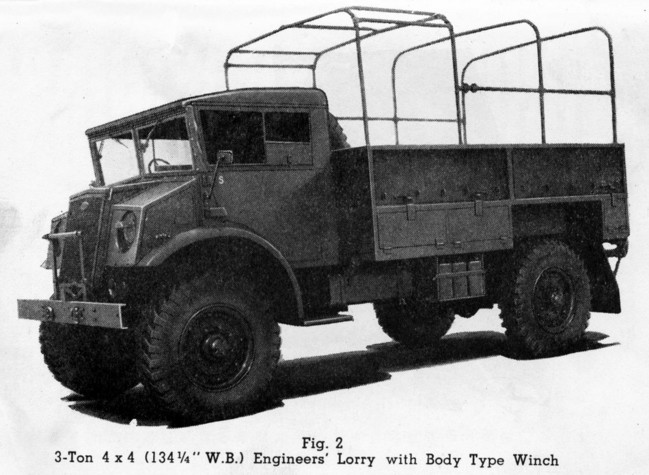 F60L official photo
F60L official photo
Specs were: Engine: Ford V8 3,917 ccm3 with carburettor, 95 hp. at 3000 rpm, 4 speed gearbox, 2 speed transfer case. Four drum brakes with vacuum-assisted hydraulic control. Dimensions: Lenght 5.35m, Width: 2.5m, Height: 2.66m. Wheelbase 2.92m. Weight: 7,500 kg.
The F60S was also declined into multiple bodies, but with less variants than the larger long wheelbases. The basic ones were troop and supply transport lorries. They were not chosen as based for armoured cars, probably because of the weal engine.
Ford 4x4 F60L
 Ford F60L Ambulance (pinterest)
Ford F60L Ambulance (pinterest)
Same engine (Ford V8 3,917 ccm3 with carburettor, 95 hp. at 3000 rpm) but dimensions 5.95m long overall, same weight, height. The longer wheelbase made it ill-suited for an armoured version. It was however more practical as troop carrier with the max capacity of all CMP trucks.
Ford CMP F60T tractor
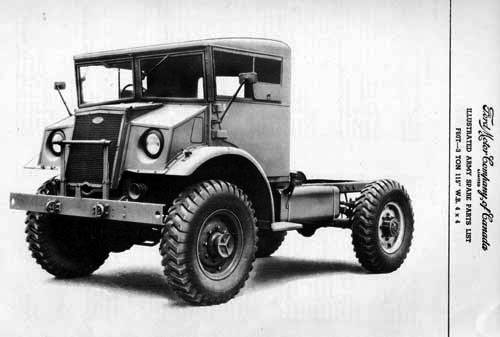 Official documentation photo
Official documentation photo
Basically a F60S (same wheelbase) so same dimensions but without flatbed and instead attach point to hold the payload. It was basically a composite with various sizes and types of trailers. F6-T and semi-trailer was also accompanied by the F602L tanker. The latter was the standard Canadian tani-refueller truck, carrying 1,500 gallon in a frameless tanker petrol trailer.
Chevrolet CMP C60S
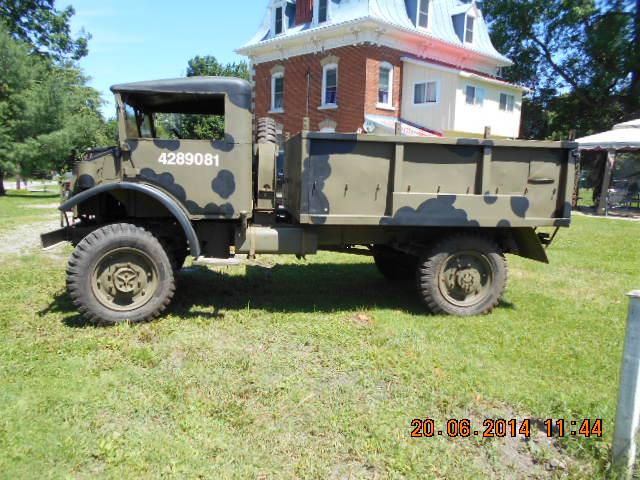
Mensurations close to the F60S, Lenght 4,35 m, Width 2.13 m, Height 2.05 m, wheelbase as said above to be 3.40m. But the engine was the GM 216 6 inline, 216 cu in (3.5 L) I6 capable of 85 hp (63 kW) for 80 kph in the best conditions. Declined into many variants, the standard troop transport, supply truck, dump truck (witn hinged flatbad at the back, low metal only sides... But also specialized ones such as the gasoline tank truck and workshop. The most common utility vehicle with flushed flatbed and transformation was the wrecker truck. One of the most common variants. It came complete with the same installation as for the C30 Wrecker. It should be added that a C60X wrcker also has been made.
Chevrolet CMP C60L
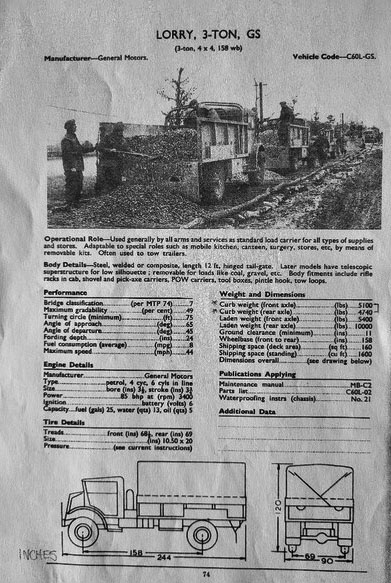 Official plate C60L
Official plate C60L
Same as the F60L (but 6.19 meters or 244 inches long overall) except for the engine, basic GM 216 6 inline, 216 cu in (3.5 L) I6. Also declined into multiple variants, the same as the F60L.
The Ford F60H 6x4 and Chevy C60X 6x6
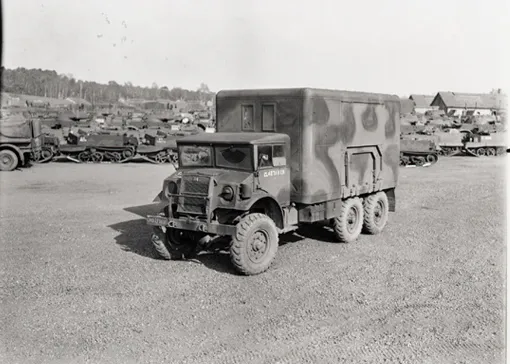 Chevy C60X in a reenacment
Chevy C60X in a reenacment
The Chevy variant also differed in having a new power unit, the 270 cu in GMC straight-6; It had as valvetrain and OHV system with 2 valves per cylinder, ran on Gasoline but was Water-cooled. Eliminated from Operations in hot climate (Tunisia-Italy) it was instead quite popular later in Italy and in France. With its 270-cubic-inch (4.4 L) capacity it had far more torque. Produced from 1941 through 1963, bore was 3.78125" and stroke was 4 inches (101.6 mm) for 133 HP @ 3600 rpm and torque 244 lb ft @ 1300 rpm. Between its 6x6 train and powerful engine, it was envisioned as a Canadian 6x6 equivalent to the Greyhound, but nothing came of it.
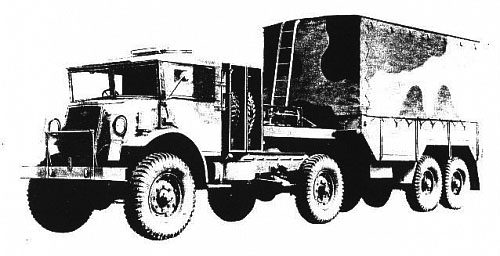 F60T with semi-trailer
F60T with semi-trailer
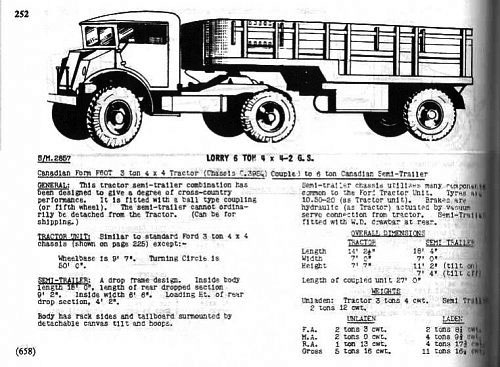 CMP Ford F60T tractor
CMP Ford F60T tractor
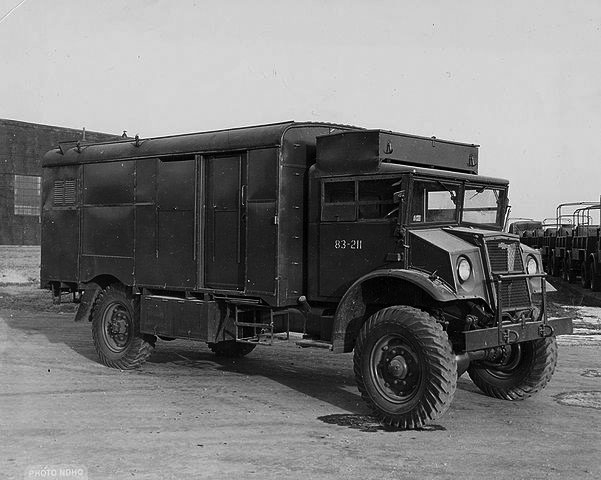
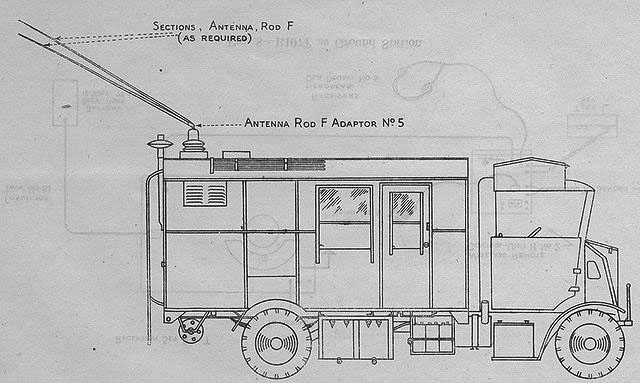
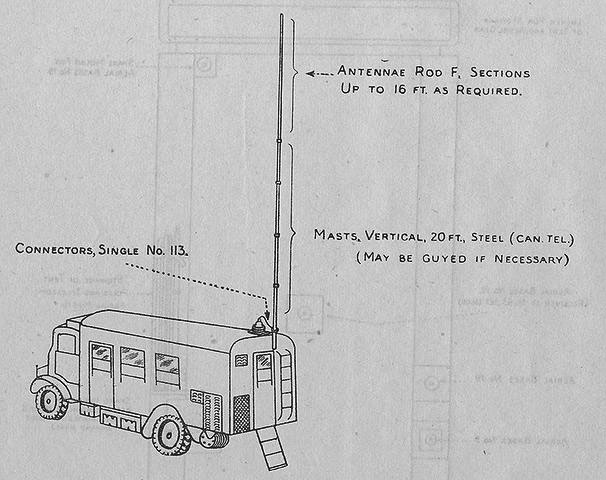
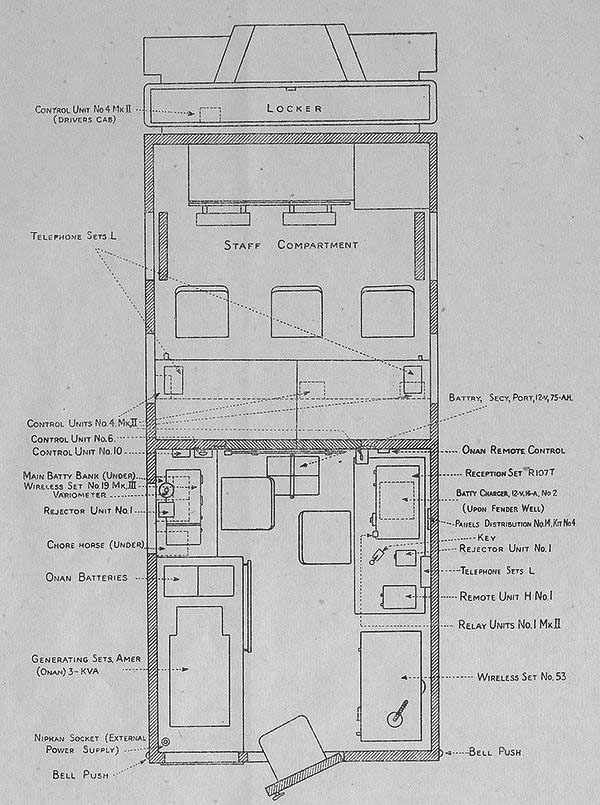 C60L Command High Power variant photo and diagrams
C60L Command High Power variant photo and diagrams
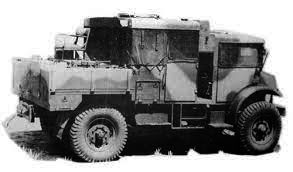 F60L with workshop
F60L with workshop
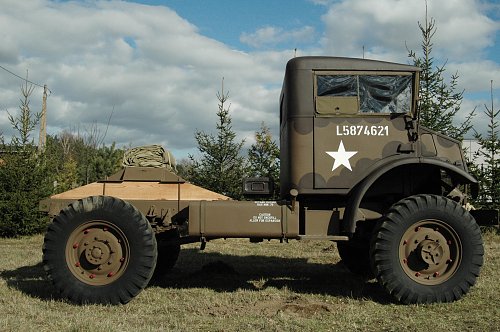 Ford F60T with semi trailer
Ford F60T with semi trailer
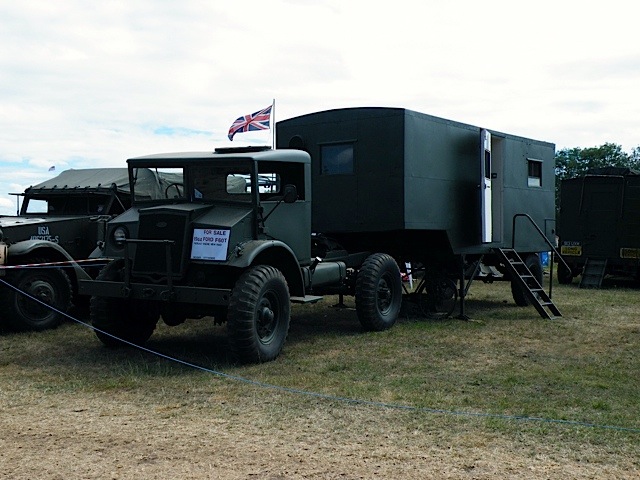 C60T with workshop trailer
C60T with workshop trailer
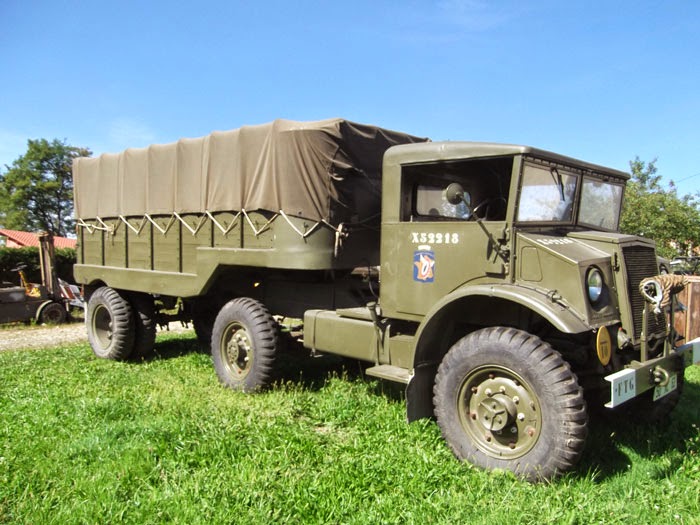 Free French C60T
Free French C60T
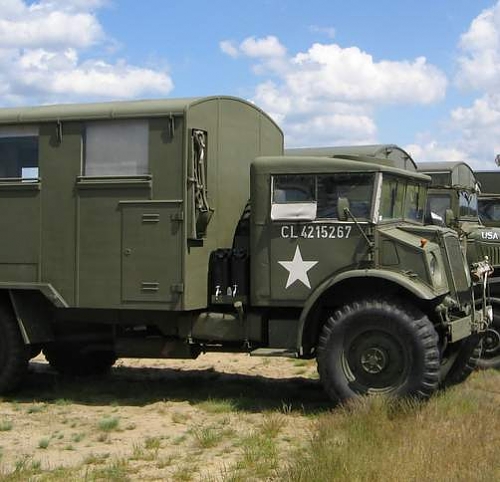 F60L workshop
F60L workshop
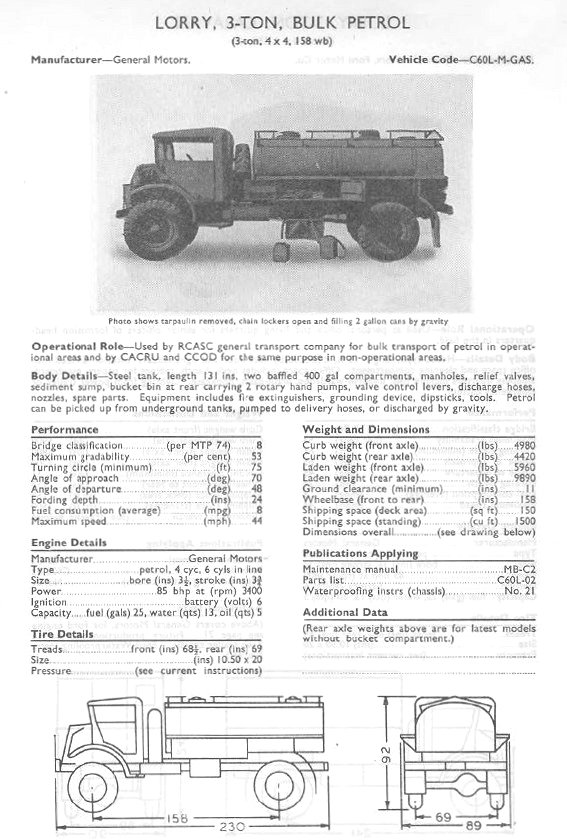 C60L fuel truck ONI
C60L fuel truck ONI
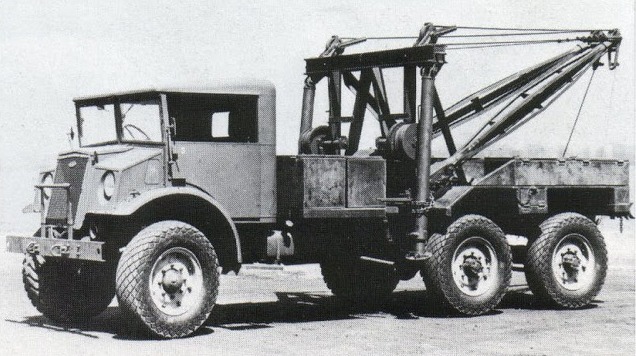 Ford F60H wrecker
Ford F60H wrecker
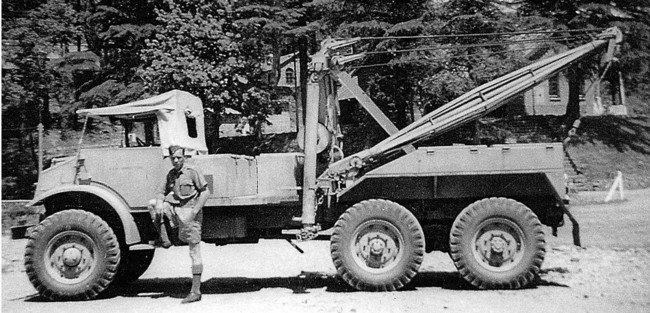 Same, note the open cab with tarpaulin
Same, note the open cab with tarpaulin
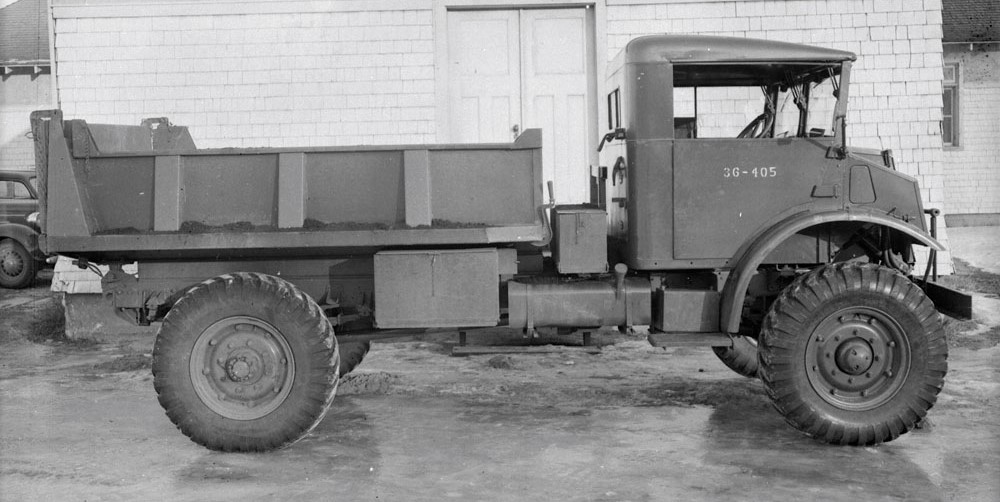 C60L dump truck
C60L dump truck
The rare half-track CMP
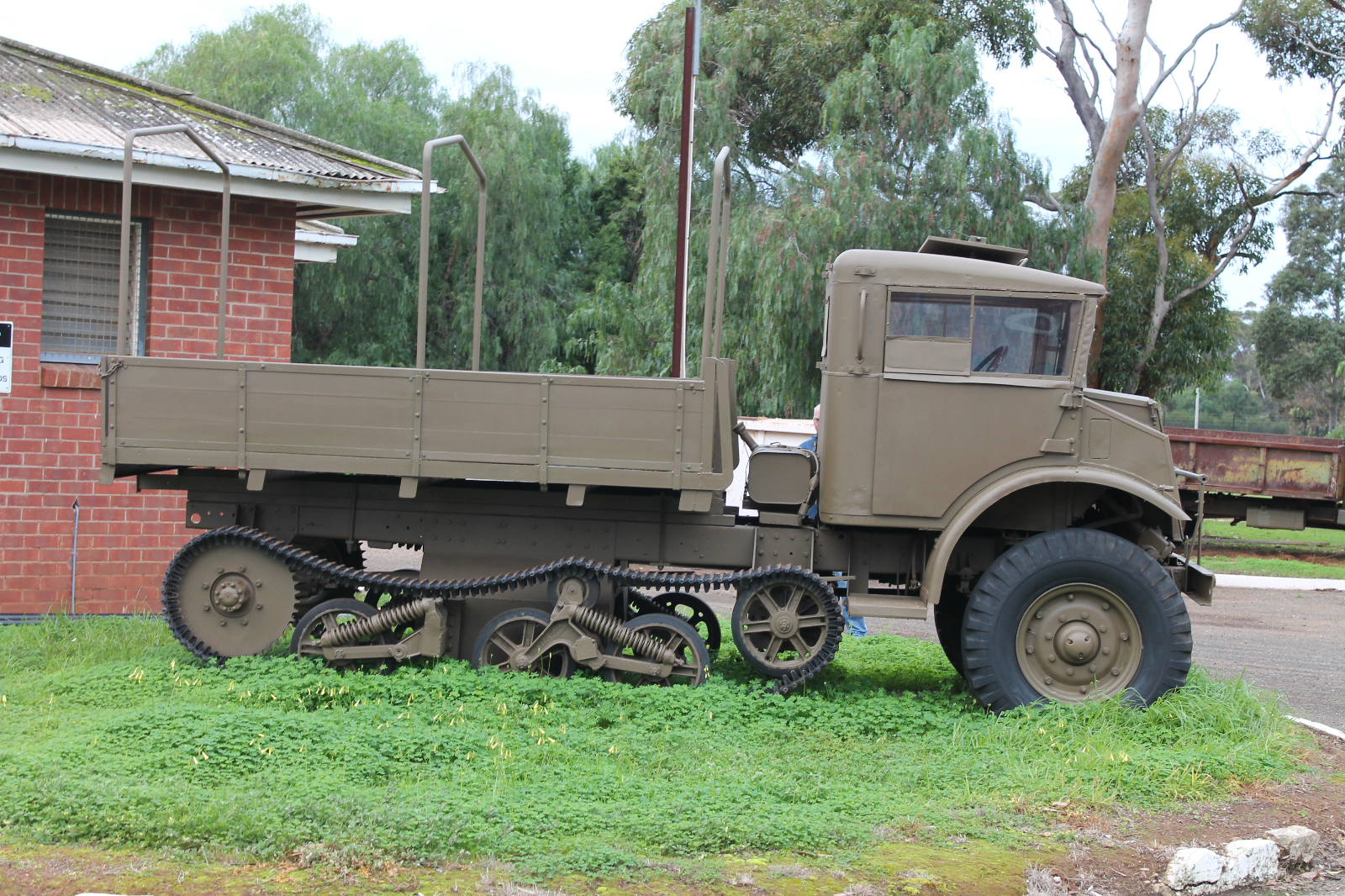 Side view, HD photo by Graeme Molineux, source at the end of the article.
Side view, HD photo by Graeme Molineux, source at the end of the article.
This was a rare experimental variant, using the also Canadian mass-produced running gear from a Universal Carrier. It did not went into production as apparently this was not a good idea. But it could have become an equivalent of the Opel Maultier, available in large quantities. The allies encountered less adverse conditions than Germany on its own eastern front area between the Autumn and spring's infamous "rasputitsa". The allies encounter deep mud at the end of the Tunisian compaign, in Italy by winter also, and in northrn France and netherlands, although there were highly urbanized areas with an excellent road network. There was simply no need for them but in special occasions.
Chevrolet 8443/C60L
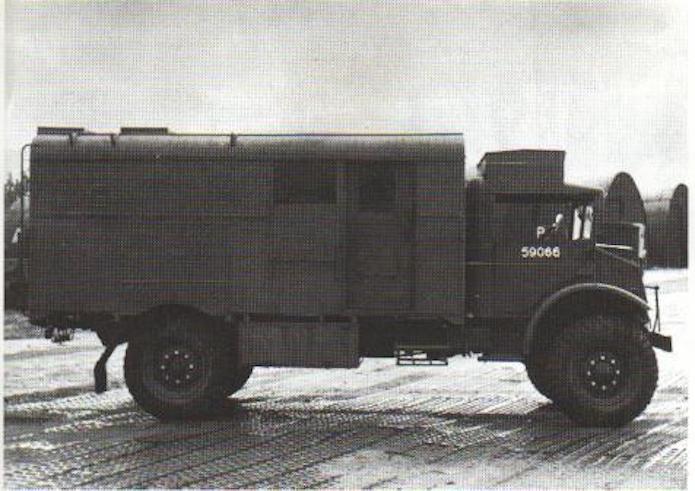
This type of vehicle was used by the Royal Canadian Signal Corps and divisional HQs. Multi-role, it existed in several specialized versions for transmissions: Low and high power radio station, EM/REC terminal, encryption office, cartography, telephone exchange, etc. Each variation required that different equipment be installed in a specialized shelter. The shelter, made of metal, measured approximately 3.90 m. It housed the equipment and workstations of the operators. It was equipped with side and rear doors. Various chests including the chest containing the technical batteries were located under the floor. Some versions were equipped with an articulated radio frame. The elements of the antenna mast were stored in a rack located on the right side of the shelter. The top of the Chevrolet cabin was also equipped with a large storage box.
The CMP in action
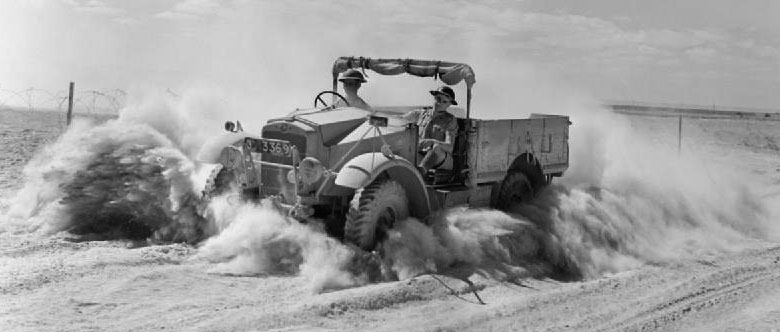 British 15 CWT North Africa November 1940
British 15 CWT North Africa November 1940
CMP trucks saw service around the world in the North African Campaign, the Allied invasion of Sicily, the Italian Campaign, the Soviet Front, the Burma Campaign, the Battle of the Philippines (1941–42), the liberation of Northwest Europe, and the Western Allied invasion of Germany. CMP trucks also served in post-war conflicts in Indonesia, French Indochina, and the Portuguese colonies in Africa. This chapter is going to be gradually expended and uptaded.
 C60 Field Ambulance version
C60 Field Ambulance version